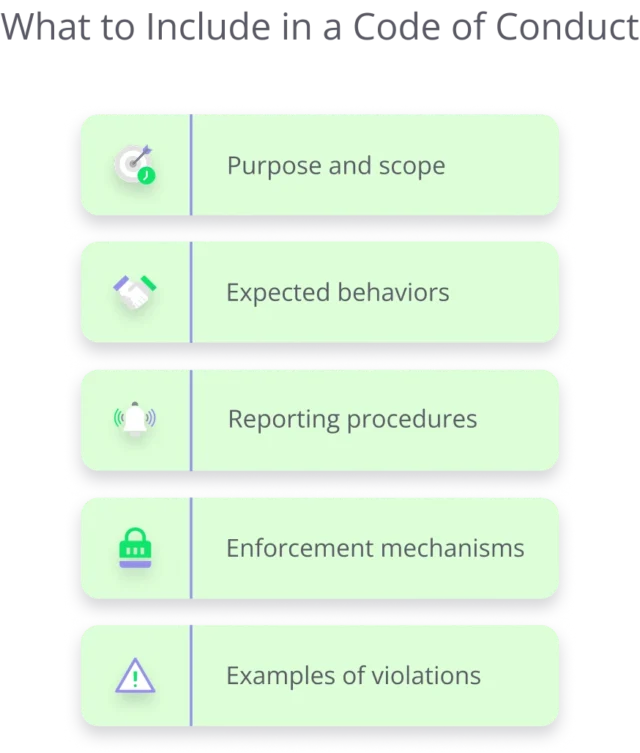Every successful organisation needs a strong code of conduct to set the tone for ethical behaviour and guide employees in their daily decisions. A well-crafted code of conduct isn’t just a document to satisfy regulators – it’s a practical tool that shapes company culture and protects your business’s integrity.
This guide explains what a code of conduct is, why it’s important, how to write one, and how to enforce it effectively in your workplace. We’ll also show how modern solutions like Logwise can streamline policy management and ensure your code of conduct truly comes to life.
What is a Code of Conduct?
A code of conduct is essentially a written set of values, rules, and principles that outline the expectations an employer has for employee behaviour. It links the company’s broader mission and core values to concrete guidelines for day-to-day conduct. In other words, the code translates high-level ethical principles into specific do’s and don’ts that staff are expected to follow.
This can range from overarching ideals (like integrity and respect) to detailed policies on issues such as dress code, use of company assets, or break times. By articulating these standards, the code of conduct reflects the organisation’s culture and the leadership’s expectations for all team members.
Why a Code of Conduct Is Important
A robust code of conduct isn’t just corporate window-dressing – it’s fundamental to running an ethical, compliant business. The code establishes upfront what behaviours are expected (and unacceptable) at work. A good ethical code of conduct therefore provides a framework for employees to make ethical choices. This empowers employees to handle grey areas by referring back to the company’s stated values and rules.
From a compliance perspective, a code of conduct is indispensable. It helps the organisation comply with laws and regulations by formalising policies on things like anti-bribery, insider trading, equality, and safety. Living up to a public code of conduct shows clients, customers, and partners what your company stands for. It signals that the company takes ethics seriously.
In the absence of a code of conduct, companies are relying on individual interpretation of right and wrong – a risky proposition that can lead to inconsistency or wrongdoing. A strong code of conduct, supported by leadership, is therefore a cornerstone of good governance and compliance.
Key Elements of an Effective Code of Conduct
Every organisation’s code of conduct will reflect its unique values and risk areas, so no two codes are identical. However, effective codes of conduct tend to cover several common themes. When writing your code, consider including guidance in the following areas:
- The core values or principles that guide the business, in which the section answers, “What do we, as a company, stand for?” This part might include commitments to honesty, respect, diversity, sustainability, community involvement, etc. These high-level values set the tone for the rest of the code.
- A description of the standards expected from employees in their day-to-day work. This typically covers professionalism and respect in the workplace. Key topics often addressed are anti-discrimination and harassment policies, maintaining a respectful workplace, proper use of company property, guidelines for social media conduct when representing the company, and rules for professional communication.
Purpose of Code of Conduct
The code of conduct should also summarise important internal policies that affect daily operations. This might include seemingly mundane but important rules such as attendance and punctuality requirements, dress code, use of IT and email, health and safety protocols, and so on. While these might exist as separate HR policies, referencing them in the code of conduct ensures employees understand that following these rules is part of ethical conduct too.
It’s also important to include guidance on avoiding conflicts of interest – situations where an employee’s personal interest might clash with their duty to the company. This could be a brief statement requiring employees to disclose any potential conflicts (such as outside jobs, financial interests in competitors or suppliers, family relationships that overlap with business, etc.).
A good business code of conduct guides how employees should behave not just internally but also with clients, customers, vendors, and the public. It should also address the protection of sensitive information and assets such as data privacy and intellectual property. Finally, an effective code of conduct explains what employees should do if they suspect a violation and what happens if they violate the code.

Code of Conduct Example
Designing a brilliant code of conduct can be a demanding task, which is why we have provided a rough outline to help companies that might be searching for “what does a code of conduct include”, or similar terms. This example deals with a UK Fintech company but can be easily modified to fit other areas and industries, as it only serves as a guide and starting point for how to write a corporate code of conduct.
Code of Conduct Core Values
We uphold integrity, compliance, transparency, and respect in all our work with colleagues, customers, and partners. We act honestly and responsibly in everything we do.
Professional Conduct
Employees should act professionally and treat others with respect. We treat colleagues and customers fairly, avoid discrimination or harassment, and use company resources (physical and digital) responsibly. We also maintain confidentiality and protect sensitive data.
Policies & Compliance
We comply with all internal policies and relevant laws. This includes data protection standards such as GDPR, anti-bribery laws such as the UK Bribery Act, conflict-of-interest rules, and applicable financial regulations, including anti-money laundering requirements and more.
Speak Up
We encourage anyone to speak up and raise concerns about unethical behavior, policy violations, or compliance issues through internal channels (e.g., a supervisor, compliance officer, or confidential hotline). All reports are treated confidentially, and the company protects those who speak up in good faith from retaliation.

How Logwise Supports Code of Conduct Compliance
Logwise is an innovative compliance platform that can help organisations bring their code of conduct from paper to practice. Writing a code is step one – implementing it consistently is the real challenge. This is where Logwise’s Policy Management module becomes invaluable. It provides a structured way to distribute your code of conduct to all employees, collect their attestations, and monitor compliance on an ongoing basis.
With Logwise, you can maintain a centralised library of policies and codes (with version control), ensuring everyone always accesses the latest code of conduct. When new codes or updates are added, the system delivers it to employees instantly through a user-friendly portal. No more sending PDFs via email and hoping people read them – Logwise tracks who has opened the document and can even require employees to acknowledge and accept them.
Ensuring Acknowledgement and Understanding
A critical part of enforcement is getting that acknowledgment from employees that “I have read and understood the code.” Logwise automates this attestation process with a click of a button. You can request electronic signatures or require users to answer a short quiz to confirm understanding.
The platform timestamps each attestation, giving you an audit trail of compliance. This means at any point, you can generate a report to see, for example, that 98% of staff have read the code of conduct, and quickly chase the remaining 2%. Such audit-ready reporting is built in, saving compliance officers countless hours.
Interactive Dashboard
From an oversight perspective, Logwise offers a dashboard for compliance officers and HR to see the status of policy compliance. You get instant visibility into who has complied, who might need additional help or reminders, and which areas of the organisation might be lagging. This lets you focus enforcement efforts where they’re needed most.
Say one department has several people not acknowledging the code – the compliance team can reach out to that department’s manager to intervene. Or if quiz results show a common question most people got wrong, you know that part of the code might need clearer explanation or additional training. Such data-driven insight is incredibly useful for continuously improving ethical compliance.
User-Friendly Platform
An often overlooked factor in enforcement is convenience. Logwise’s platform is accessible on multiple devices, meaning an employee can read and sign the code on their work computer or even from their phone or tablet.
This is especially helpful for organisations with frontline workers or those not often at desks – everyone can engage with the code with minimal friction. When policies are easy to access, employees are more likely to consult them when in doubt, reinforcing proper behaviour at the moment of decision.
Every change to your code of conduct (or any policy) can be managed through Logwise with full version history. If regulators or auditors ever ask, you can readily show “Version 3 of our Code of Conduct was in effect during 2025, and here’s proof all employees attested to it, plus records of the training delivered alongside.” This level of documentation is gold-standard for compliance programs – it demonstrates a proactive, structured approach to ethical governance.
Conclusion
For organisations aiming to build a culture of integrity, using technology like Logwise means your code of conduct is not just a document – it’s an active program supported by innovative tools. Trustworthy, approachable, and innovative is not only how you want your code of conduct to come across, but also how Logwise delivers compliance solutions to support your ethical journey.
Book a demo to see how Logwise streamlines policy management from drafting to enforcement.
Code of Conduct vs. Code of Ethics: What’s the Difference and Why It Matters
When organisations embark on creating policies for ethical conduct, two terms often emerge: code of conduct and code of ethics. These phrases are sometimes used interchangeably, which can cause confusion. In this […]
Code of Conduct vs. Code of Ethics: What’s the Difference and Why It Matters
When organisations embark on creating policies for ethical conduct, two terms often emerge: code of conduct and code of ethics. These phrases are sometimes used interchangeably, which can cause confusion. In this […]
Conflict of Interest Explained: Types, Policies, and Real Examples
Learn how to identify and manage conflicts of interest using effective policies and compliance tools to prevent risk and ensure accountability.
Board of Directors Conflict of Interest: Compliance Best Practices
Explore how to manage board conflicts of interest with clear policies, structured workflows, and secure disclosure tools for stronger governance.
How to Choose the Best Compliance Software Platform and Vendor
Learn how to choose the right compliance software to reduce risk, eliminate manual tasks, and ensure oversight in a changing regulatory environment.




